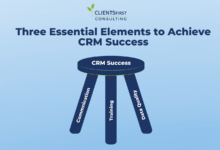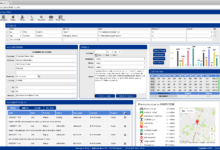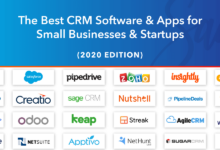CRM and Phone Integration: Streamlined Business
CRM and phone integration isn’t just about connecting two systems; it’s about fundamentally changing how your business operates. Imagine a world where customer interactions are seamlessly logged, calls are automatically routed, and valuable data is instantly accessible. This isn’t science fiction – it’s the reality offered by integrating your CRM with your phone system, boosting efficiency and improving customer relationships in ways you never thought possible.
This integration streamlines workflows, enhances team collaboration, and provides invaluable insights into customer behavior. We’ll explore the different types of integrations, implementation strategies, and the significant impact this synergy has on sales, customer service, and overall business growth. From choosing the right system to maximizing its potential, we’ll cover everything you need to know to successfully implement and leverage CRM and phone integration.
Defining CRM and Phone Integration
CRM and phone integration represents a powerful synergy, boosting efficiency and improving customer relationships. Essentially, it connects your customer relationship management (CRM) software with your phone system, allowing for seamless data flow and enhanced communication. This integration streamlines workflows, improves data accuracy, and ultimately leads to better customer service and increased sales.
Core Functionalities of CRM Software
CRM software is designed to manage and analyze customer interactions and data throughout the customer lifecycle. Core functionalities typically include contact management (storing customer information, interactions, and purchase history), sales force automation (managing leads, tracking deals, and forecasting sales), marketing automation (managing marketing campaigns and tracking results), customer service and support (managing support tickets and tracking resolution times), and reporting and analytics (providing insights into customer behavior and sales performance). These functions work together to provide a comprehensive view of the customer, enabling businesses to personalize interactions and improve overall customer experience.
Types of Phone Integrations Available for CRMs
Several types of phone integrations exist, each offering different levels of functionality. These include:
* Click-to-call: This basic integration allows users to initiate calls directly from the CRM by clicking a phone number. It’s simple to implement but offers limited features.
* Screen pops: When a call comes in, this integration displays the caller’s information (from the CRM) on the agent’s screen, eliminating the need to manually search for the contact. This improves call handling efficiency.
* Call logging: This automatically logs call details (date, time, duration, caller ID) in the CRM, ensuring a complete record of customer interactions. It enhances data accuracy and simplifies reporting.
* Call recording: This feature records calls for quality assurance, training, or compliance purposes. It can be a valuable tool for improving customer service and identifying areas for improvement.
* Predictive dialing: This advanced feature automatically dials numbers from a list, connecting agents with potential customers more efficiently. It’s often used in outbound sales and marketing.
* Interactive Voice Response (IVR): This allows customers to navigate a phone menu to reach the appropriate department or agent, improving call routing efficiency and reducing wait times. This is often integrated for better customer self-service options.
Benefits of Integrating Phone Systems with CRM Platforms
Integrating phone systems with CRM platforms offers significant advantages:
* Improved Customer Service: Faster call handling, access to complete customer history, and personalized interactions enhance customer satisfaction.
* Increased Sales Efficiency: Streamlined workflows, improved lead management, and better sales tracking lead to higher conversion rates.
* Enhanced Team Collaboration: Shared access to customer data and call logs improves team communication and coordination.
* Better Data Accuracy: Automated call logging eliminates manual data entry, reducing errors and ensuring data consistency.
* Improved Reporting and Analytics: Comprehensive call data provides valuable insights into customer behavior and sales performance, allowing for data-driven decision-making.
Businesses that Benefit Most from CRM Phone Integration
Businesses with high call volumes, those reliant on strong customer relationships, and those needing detailed sales tracking will benefit most. This includes:
* Customer service-centric businesses: Call centers, help desks, and support teams greatly benefit from improved call handling and customer data access.
* Sales-driven organizations: Sales teams can improve efficiency and close deals faster with better lead management and call tracking.
* Businesses with large customer bases: Managing interactions with many customers is significantly easier with automated data logging and reporting.
* Healthcare providers: Efficiently managing patient communication and maintaining accurate medical records are crucial.
Comparison: On-Premise vs. Cloud-Based CRM Phone Integrations
| Feature | On-Premise | Cloud-Based | Comparison |
|---|---|---|---|
| Cost | High initial investment, lower ongoing costs | Lower initial investment, recurring subscription fees | Cloud-based offers lower upfront cost but potentially higher long-term expenses. |
| Scalability | Difficult and expensive to scale | Easy and cost-effective to scale | Cloud-based solutions are much more adaptable to changing business needs. |
| Maintenance | Requires dedicated IT staff for maintenance and updates | Vendor handles maintenance and updates | Cloud-based eliminates the need for internal IT expertise related to the phone system. |
| Security | Security responsibility lies with the business | Vendor handles security | Security is often considered more robust with reputable cloud providers. |
Cost and ROI
Integrating your CRM and phone system offers significant potential benefits, but understanding the associated costs and potential return on investment (ROI) is crucial for making an informed decision. This section details the various cost components, compares integration methods, and provides a framework for calculating and justifying your investment.
Cost Components of CRM and Phone Integration
The total cost of integrating your CRM and phone system comprises several key elements. These include the initial software and hardware costs, ongoing maintenance and support fees, and potential consulting or implementation charges. The specific costs will vary depending on factors like the size of your business, the complexity of your systems, and the chosen integration method.
Comparison of Integration Methods
Different integration methods carry varying cost implications. A direct, custom integration, while offering the most flexibility and tailored functionality, typically involves higher initial costs and ongoing maintenance compared to using a pre-built integration app or a cloud-based solution. Pre-built integrations are generally cheaper upfront but may lack the customization options of a custom solution. Cloud-based solutions often operate on a subscription model, with costs varying depending on the number of users and features. Consider the trade-offs between cost and customization when selecting your integration method.
Calculating Return on Investment (ROI)
Calculating the ROI of your CRM and phone integration requires a careful assessment of both costs and benefits. Start by calculating the total cost of the integration, including initial setup, ongoing maintenance, and any staff training. Then, quantify the potential benefits. This could include increased sales efficiency due to improved call tracking and lead management, reduced operational costs through automated processes, and improved customer satisfaction leading to increased customer lifetime value. A simple ROI calculation can be expressed as:
ROI = (Net Profit / Total Investment) x 100%
Where ‘Net Profit’ represents the difference between increased revenue and reduced costs resulting from the integration, and ‘Total Investment’ encompasses all associated expenses.
Justifying the Investment to Stakeholders
To effectively justify the investment to stakeholders, present a clear and concise business case that highlights the potential benefits and ROI. This should include a detailed cost-benefit analysis, demonstrating how the integration will improve efficiency, reduce operational costs, and ultimately drive revenue growth. Include specific examples of how the integration will address existing business challenges and support the achievement of strategic goals. For example, quantify the potential time savings from automated call logging and the increased sales conversion rate from improved lead management.
Potential Cost Savings and Revenue Increases
The following table illustrates potential cost savings and revenue increases associated with CRM and phone integration. These figures are illustrative and will vary based on individual business circumstances. Remember to tailor these estimates to your specific situation for a more accurate projection.
| Cost Factor | Initial Cost | Ongoing Cost | Potential ROI |
|---|---|---|---|
| Software/Hardware | $5,000 – $20,000 | $500 – $2,000/month | Increased efficiency leading to faster lead response and higher conversion rates |
| Implementation/Consulting | $2,000 – $10,000 | $0 – $500/month (for ongoing support) | Improved agent productivity through streamlined workflows and reduced manual data entry |
| Training | $500 – $2,000 | $0 | Enhanced customer experience leading to increased customer satisfaction and loyalty |
| Reduced manual data entry | – | $1,000 – $5,000/month (estimated cost savings) | Faster lead qualification and reduced sales cycle length |
| Improved Sales Conversion | – | $5,000 – $20,000/month (estimated revenue increase) | Better reporting and analytics enabling data-driven decision making |
Ultimate Conclusion
Ultimately, integrating your CRM and phone system is an investment in efficiency, improved customer relationships, and measurable business growth. By streamlining communication, centralizing data, and gaining actionable insights, businesses can significantly enhance their operational effectiveness and achieve a higher return on investment. Don’t just manage your customers; understand them. Embrace CRM and phone integration and unlock your business’s true potential.





